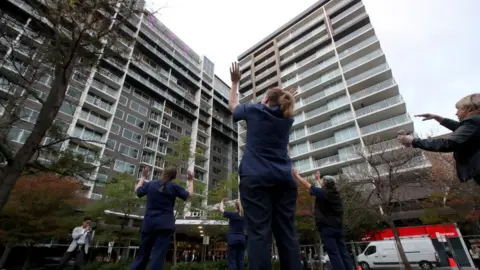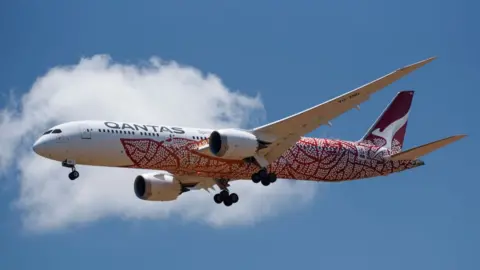Australians stuck overseas 'abandoned' by their own country
 MANDEEP SHARMA
MANDEEP SHARMAAustralian citizen Mandeep Sharma has been deserted by his government.
He is one of the 9,000 Australians stranded in India, left to fend for themselves after Canberra this week banned all flights from the Covid-ravaged nation until mid-May.
Mr Sharma has a wife and two daughters in Adelaide. He travelled to India last month to attend his father's funeral and was due to fly back next week.
Now he fears contracting the virus and being separated from his family indefinitely.
On Saturday, Australia also announced it would jail anyone who attempts to return from India. For people like Mr Sharma, trying to get home is now a criminal act - punishable by five years jail or an A$66,000 (£36,800; $51,000) fine.
It's just the latest hardline action taken by the government to keep the virus out of the country. Australia has enjoyed near zero- infection rates and recorded just 910 deaths - far fewer than most other nations.
It attributes its virus success to its strict border controls and quarantine measures. But these have also locked out thousands of Australians from returning home over the course of the pandemic.
The India ban also marks an extraordinary escalation - the first time the country has made it a crime for its own citizens to return home.
Why can't citizens get in?
Australia was one of the first nations to close its borders in March 2020, barring all arrivals except returning nationals, residents, and people granted exemptions (including celebrities, sports stars and contract workers). Since October 2020, it has also allowed travellers from virus-free New Zealand.
All arrivals are forced to undertake - and fund - a two week quarantine stay at at a hotel, typically in a state capital city.
Currently, around 36,000 nationals are registered for government help to fly home, a level that has remained consistent over the past year. Prior to the pandemic, there were estimated to be about one million Australians living overseas.
Early on in the quarantine programme, a problem emerged. The number of people returning home - mostly from New Zealand, the US and the UK - threatened to overwhelm the system. There were only so many hotel rooms available.
So the government looked for a solution. Instead of expanding the system - for example, adding a purpose-built quarantine centre - authorities drastically cut back the number of plane arrivals allowed in each week.
 Getty Images
Getty ImagesPrime Minister Scott Morrison initially sold the "travel caps" as a temporary limit. But the cap has become a permanent fixture.
Currently about 7,000 people are allowed in each week. But the level can be reduced at any time - causing flight cancellations and route changes. In January, it was halved due to community outbreaks and virus mutations.
Many stranded Australians say they would be happy if they felt like they were joining an ordered queue to get home. But the system has proven chaotic and arbitrary, and lacks measures to prioritise those most in need.

Who has been allowed in:
 Reuters/Getty Images/EPA/BBC
Reuters/Getty Images/EPA/BBC
That means who gets to go home essentially comes down to the commercial airlines. The limit on arrivals into Australia has driven up airfares, pushing them out of reach for many.
It has led to the current situation, where less than half of those arriving in Australia in February were citizens.
The government has organised a number of repatriation flights, but getting a seat is highly competitive. They're also not free.
Is hotel quarantine adequate?
Increasingly, no. Since the more infectious UK variant arrived in Australia, it's tested the quarantine system.
Perth endured a three-day lockdown last week after the virus leaked out of one of the hotels. This marked the seventh time since November that an Australian city has plunged into a snap lockdown due to a quarantine leak.
In the past six months, Australia has seen 16 breaches of its hotel quarantine system as more infectious strains have come in. Breaches include transmission between travellers in separate rooms, and infections passed onto workers.
Despite efforts to fix hotel quarantine, including improving air circulation and safety protocols, the virus keeps getting out.
Still, the 16 breaches are few compared to the system's overall success. More than half a million people have been processed through hotel quarantine, says Mr Morrison.
But each breach is a risk to the community, and the recent examples have sparked alarm about the suitability of quarantining people in city hotels.
How could quarantine be improved?
Critics have demanded a system overhaul to allow more Australians to come home. State governments, tired of having to plunge cities into lockdown, have called for federal government to help build more appropriate facilities.
Experts have consistently suggested that travellers be moved out of city hotels and into purpose-built centres in regional areas.
Many point to the success of the Howard Springs centre, a refurbished mining camp near Darwin. Instead of people being quarantined in cramped hotel rooms with shared corridors, they stay in single-unit houses with outdoor spaces. The centre will be expanded from 800 beds to 2,000 next week.
 Getty Images
Getty ImagesOn Thursday, the state of Victoria announced it would begin work on designing a similar facility because "we need options that we can take up to make the community safer".
"It is clear the virus will be with us for some time," said Acting Premier James Merlino, who also mentioned Australia's delayed vaccine rollout.
But the new quarantine centre will need federal buy-in. He called on Canberra to stump up the A$100m (£56m; $78m) investment needed to build the centre by the end of the year.
Experts have also suggested the alternative of home quarantine, which has been a success in places like Taiwan and Singapore.
Will the system change?
As the plight of stranded Australians stretches on, calls for change are increasing.
The India ban and criminalisation of returning citizens has also sparked alarm and outrage. Many have raised human rights criticisms.
But many who've been stuck overseas for months believe their pleas will be ignored.
Polling throughout the pandemic has shown broad support among Australians at home for keeping the borders shut.
And when community fear has been highest, during quarantine outbreaks and lockdowns, there have even been public debates about blocking Australians from returning altogether.
In those periods, such as in Western Australia's recent lockdown, politicians have also sought to attribute blame to individuals, rather than scrutinise the faults of quarantine.
For people like Mr Sharma, who travelled to India to mourn his father's death, the lack of compassion and community solidarity is dispiriting.
"It's really devastating to see when people on social media say: 'Just let them stay there'. What kind of thing is that to say about a fellow Australian?"

